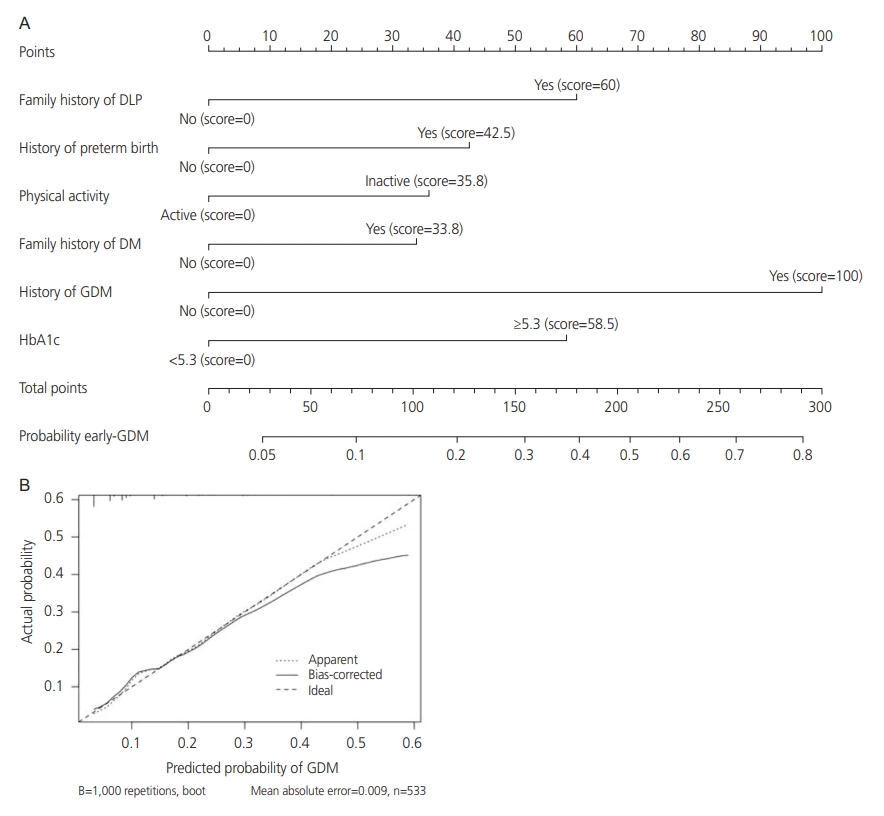3. National Collaborating Centre for Women’s and Children’s Health. Diabetes in pregnancy: management of diabetes and its complications from preconception to the postnatal period [Internet] Bethesda (MD): National Center for Biotechnology Information; c2015 [cited 2021 Feb 3]. Available from:
https://www.ncbi.nlm.nih.gov/books/NBK293625/
.
4. ACOG practice bulletin No. 190: gestational diabetes mellitus. Obstet Gynecol 2018;131:e49-64.


6. Gyasi-Antwi P, Walker L, Moody C, Okyere S, Salt K, Anang L, et al. Global prevalence of gestational diabetes mellitus: a systematic review and meta-analysis. [Internet] New York (NY): The New American Journal of Medicine; c2020 [cited 2021 Feb 3]. Available from:
https://nottingham-repository.worktribe.com/output/4766016
.
7. Boriboonhirunsarn D, Sunsaneevithayakul P, Nuchangrid M. Incidence of gestational diabetes mellitus diagnosed before 20 weeks of gestation. J Med Assoc Thai 2004;87:1017-21.

8. Immanuel J, Simmons D. Screening and treatment for early-onset gestational diabetes mellitus: a systematic review and meta-analysis. Curr Diab Rep 2017;17:115.


9. US Preventive Services Task Force, Davidson KW, Barry MJ, Mangione CM, Cabana M, Caughey AB, et al. Screening for gestational diabetes: US preventive services task force recommendation statement. JAMA 2021;326:531-8.


12. Amaefule CE, Sasitharan A, Kalra P, Iliodromoti S, Huda MSB, Rogozinska E, et al. The accuracy of haemoglobin A1c as a screening and diagnostic test for gestational diabetes: a systematic review and meta-analysis of test accuracy studies. Curr Opin Obstet Gynecol 2020;32:322-34.


13. Phaloprakarn C, Tangjitgamol S. Risk assessment for preeclampsia in women with gestational diabetes mellitus. J Perinat Med 2009;37:617-21.


15. Arbib N, Shmueli A, Salman L, Krispin E, Toledano Y, Hadar E. First trimester glycosylated hemoglobin as a predictor of gestational diabetes mellitus. Int J Gynaecol Obstet 2019;145:158-63.


16. Boriboonhirunsarn D, Sunsaneevithayakul P, Pannin C, Wamuk T. Prevalence of early-onset GDM and associated risk factors in a university hospital in Thailand. J Obstet Gynaecol 2021;41:915-9.


17. Carpenter MW, Coustan DR. Criteria for screening tests for gestational diabetes. Am J Obstet Gynecol 1982;144:768-73.


18. World Health Organization. WHO STEPS surveillance manual: the WHO STEP wise approach to chronic disease risk factor surveillance. Geneva: World Health Organization; 2005.
19. Armstrong T, Bull F. Development of the World Health Organization global physical activity questionnaire (GPAQ). J Public Health 2006;14:66-70.

20. López-Ratón M, Rodríguez-Álvarez MX, Suárez CC, Sampedro FG. OptimalCutpoints: an R package for selecting optimal cutpoints in diagnostic tests. J Stat Soft 2014;61:1-36.
21. Steyerberg EW, Harrell FE Jr. Prediction models need appropriate internal, internal-external, and external validation. J Clin Epidemiol 2016;69:245-7.


23. Wu YT, Zhang CJ, Mol BW, Kawai A, Li C, Chen L, et al. Early prediction of gestational diabetes mellitus in the Chinese population via advanced machine learning. J Clin Endocrinol Metab 2021;106:e1191-205.


25. ACOG Practice Bulletin No. 190: gestational diabetes mellitus. Obstet Gynecol 2018;131:e49-64.


27. Fong A, Serra AE, Gabby L, Wing DA, Berkowitz KM. Use of hemoglobin A1c as an early predictor of gestational diabetes mellitus. Am J Obstet Gynecol 2014;211:641.e1-7.


28. Osmundson SS, Zhao BS, Kunz L, Wang E, Popat R, Nimbal VC, et al. First trimester hemoglobin A1c prediction of gestational diabetes. Am J Perinatol 2016;33:977-82.


29. Siricharoenthai P, Phupong V. Diagnostic accuracy of HbA1c in detecting gestational diabetes mellitus. J Matern Fetal Neonatal Med 2020;33:3497-500.


30. Ryckman KK, Spracklen CN, Smith CJ, Robinson JG, Saftlas AF. Maternal lipid levels during pregnancy and gestational diabetes: a systematic review and meta-analysis. BJOG 2015;122:643-51.


31. O’Malley EG, Reynolds CME, Killalea A, O’Kelly R, Sheehan SR, Turner MJ. Maternal obesity and dyslipidemia associated with gestational diabetes mellitus (GDM). Eur J Obstet Gynecol Reprod Biol 2020;246:67-71.


32. van Leeuwen M, Opmeer BC, Zweers EJ, van Ballegooie E, ter Brugge HG, de Valk HW, et al. Estimating the risk of gestational diabetes mellitus: a clinical prediction model based on patient characteristics and medical history. BJOG 2010;117:69-75.


35. Souza ACRLA, Costa RA, Paganoti CF, Rodrigues AS, Zugaib M, Hadar E, et al. Can we stratify the risk for insulin need in women diagnosed early with gestational diabetes by fasting blood glucose? J Matern Fetal Neonatal Med 2019;32:2036-41.


36. Li W, Leng J, Liu H, Zhang S, Wang L, Hu G, et al. Nomograms for incident risk of post-partum type 2 diabetes in Chinese women with prior gestational diabetes mellitus. Clin Endocrinol (Oxf) 2019;90:417-24.


38. Glaharn P, Chumworathayi B, Kongwattanakul K, Sutthasri N, Wiangyot P. Proportion of abnormal second 50-g glucose challenge test in gestational diabetes mellitus screening using the two-step method in high-risk pregnant women. J Obstet Gynaecol Res 2020;46:229-36.


40. Lee KH, Han YJ, Chung JH, Kim MY, Ryu HM, Kim JH, et al. Treatment of gestational diabetes diagnosed by the IADPSG criteria decreases excessive fetal growth. Obstet Gynecol Sci 2020;63:19-26.


























